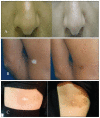Correlation of clinical efficacy and psychosocial impact on vitiligo patients by excimer laser treatment
- PMID: 24894779
- PMCID: PMC6074866
- DOI: 10.5144/0256-4947.2014.115
Correlation of clinical efficacy and psychosocial impact on vitiligo patients by excimer laser treatment
Abstract
Background and objectives: Vitiligo is a difficult disease to treat. Recently, a 308-nm excimer laser has been shown to be effective in treating vitiligo. In addition, the patients with vitiligo have impairment in their quality of life. The aim of the study was to investigate the clinical efficacy, safety, and psychosocial impact after treating vitiligo with the 308-nm excimer laser.
Design and settings: A prospective clinical trial conducted at dermatology clinics of hospitals affiliated with Qassim University, Saudi Arabia, from May 2012 to February 2013.
Patients and methods: Forty-eight patients with 105 vitiliginous patches were treated using a 308-nm excimer laser. The treatment was performed twice per week for a maximum of 48 treatments or 100% repigmentation of lesions whichever was achieved first. The assessment of the clinical response and recording of side effects were performed biweekly.
Results: Out of 105 lesions in these patients, 63 lesions (60.0%) achieved over 75% repigmentation by laser treatment, 12 lesions (11.4%) showed 51% to 75% repigmentation, 9 lesions (8.6%) showed 26% to 50% repigmentation, and another 9 lesions (8.6%) showed 1% to 25% repigmentation, while 12 lesions (11.4%) showed no repigmentation. The average (+/-standard deviation [SD]) number of sessions needed to achieve repigmentation was 16.8 (8.0), whereas the average (+/-SD) number of sessions needed to realize Grade IV repigmentation was 20.2 (15). The type of repigmentation varied between lesions. Diffuse repigmentation was the most common pattern and occurred in 34 lesions (36.6%). Facial lesions responded better than lesions located elsewhere. Skin type did not play a statistically significant role (P=.07) in the lesions response to treatment. All side effects were mild and disappeared shortly after end of treatment sessions.
Conclusion: The clinical data indicate that the treatment of vitiligo using the 308-nm excimer laser is effective and safe and improves psychosocial quality of life. Lesion location, duration of disease, and treatment duration are factors affecting the clinical and psychological outcome.
Figures
Similar articles
-
Clinical study of repigmentation patterns with either narrow-band ultraviolet B (NBUVB) or 308 nm excimer laser treatment in Korean vitiligo patients.Int J Dermatol. 2010 Mar;49(3):317-23. doi: 10.1111/j.1365-4632.2009.04332.x. Int J Dermatol. 2010. PMID: 20465673 Clinical Trial.
-
A randomized prospective study to compare the efficacy of 308-nm light-emitting diode and 308-nm excimer lamp in the treatment of facial vitiligo.Arch Dermatol Res. 2025 Jan 9;317(1):210. doi: 10.1007/s00403-024-03721-7. Arch Dermatol Res. 2025. PMID: 39786635 Clinical Trial.
-
Optimal frequency of treatment with the 308-nm excimer laser for vitiligo on the face and neck.Photomed Laser Surg. 2007 Oct;25(5):418-27. doi: 10.1089/pho.2007.2086. Photomed Laser Surg. 2007. PMID: 17975956 Clinical Trial.
-
Effectiveness of a 308-nm excimer laser in treatment of vitiligo: a review.Lasers Med Sci. 2013 May;28(3):1035-41. doi: 10.1007/s10103-012-1185-1. Epub 2012 Aug 15. Lasers Med Sci. 2013. PMID: 22892613 Review.
-
Efficacy of fire needle combined with 308 nm excimer laser therapy for vitiligo: A systematic review and meta-analysis of randomized controlled trials.J Cosmet Dermatol. 2024 Aug;23(8):2592-2602. doi: 10.1111/jocd.16308. Epub 2024 Apr 9. J Cosmet Dermatol. 2024. PMID: 38591186
Cited by
-
Psychosocial Effects of Vitiligo: A Systematic Literature Review.Am J Clin Dermatol. 2021 Nov;22(6):757-774. doi: 10.1007/s40257-021-00631-6. Epub 2021 Sep 23. Am J Clin Dermatol. 2021. PMID: 34554406 Free PMC article.
-
Variations in TAP1 and PSMB9 Genes Involved in Antigen Processing and Presentation Increase the Risk of Vitiligo in the Saudi Community.Int J Gen Med. 2021 Dec 19;14:10031-10044. doi: 10.2147/IJGM.S341079. eCollection 2021. Int J Gen Med. 2021. PMID: 34984025 Free PMC article.
-
The Treatment of Refractory Vitiligo With Autologous Cultured Epithelium Grafting: A Real-World Retrospective Cohort Study.Stem Cells Transl Med. 2024 May 14;13(5):415-424. doi: 10.1093/stcltm/szae009. Stem Cells Transl Med. 2024. PMID: 38513284 Free PMC article.
-
Prevalence and burden of vitiligo in Africa, the Middle East and Latin America.Skin Health Dis. 2023 Dec 18;4(1):e317. doi: 10.1002/ski2.317. eCollection 2024 Feb. Skin Health Dis. 2023. PMID: 38312261 Free PMC article. Review.
-
The humanistic burden of vitiligo: a systematic literature review of quality-of-life outcomes.J Eur Acad Dermatol Venereol. 2022 Sep;36(9):1507-1523. doi: 10.1111/jdv.18129. Epub 2022 May 11. J Eur Acad Dermatol Venereol. 2022. PMID: 35366355 Free PMC article.
References
-
- Malhotra N, Dytoc M. The pathogenesis of vitiligo. J Cutan Med Surg. 2013;17:153–72. - PubMed
-
- Halder RM, Nootheti PK. Ethnic skin disorders overview. J Am Acad Dermatol. 2003;48:S143–8. - PubMed
-
- Grimes PE. White patches and bruised souls: advances in the pathogenesis and treatment of vitiligo. J Am Acad Dermatol. 2004;51:S5–7. - PubMed
-
- Njoo MD, Westerhof W. Vitiligo: pathogenesis and treatment. Am J Clin Dermatol. 2001;2:167–81. - PubMed
-
- Whitton ME, Pinart M, Batchelor J, Lushey C, Leonardi-Bee J, Gonzalez U. Interventions for vitiligo. Cochrane Database Syst Rev. 2010;20:CD003263. - PubMed
Publication types
MeSH terms
LinkOut - more resources
Full Text Sources
Other Literature Sources
Medical



